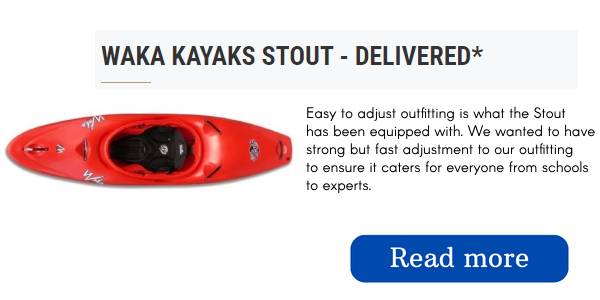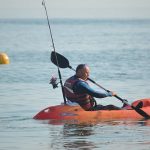So, you want to buy a whitewater kayak. When buying a whitewater kayak, consider the following:
-The type of kayak you want (e.g. creeker, playboat, river runner)
-The length and width of the kayak you need
-The Manufacturer you want
-Your Budget
-How the kayak is set up (e.g. deck, seat, footrests)
There are a lot of different whitewater kayaks on the market, even though it’s a small industry. It can be overwhelming trying to choose one. Every kayak manufacturer that CKS Online carries makes high-quality kayaks.
Some kayaks are better for beginners than others. If you choose the right one, it will improve your experience and how quickly you improve.
- We’ll start by discussing common features and kayak terms used to differentiate between types of kayaks.
- Now, we will go over the different types of whitewater kayaks.
- When deciding what type of kayak to buy, it is important to consider your goals and learning style.
Common terms to understand when buying a kayak
Outfitting
The stuff inside the boat that keeps you safe and comfortable is called outfitting. There are four main points that hold you into your kayak: your seat, backband, thigh hooks, and bulkhead (foot brace).
If you want to buy a kayak, it will come with different types of padding to help you adjust it to your body.
Many experienced paddlers prefer one brand of adjustable outfitting over another because it feels better to them.
Edges
The edge of the kayak is where the kayak transitions from the bottom (hull) to the side. The edge of the kayak is an important factor in how it moves through the water.
The choice of edge depends on the kind of kayaking you enjoy. Kayaks can have either sharp or soft edges, depending on the type of kayaking you enjoy. Carving across current is easier with sharp edges, but if your technique is not good, you may flip over more easily.
Rocker
The curve of your kayak’s hull from front to back is called the rocker. The rocker shapes the bottom of your kayak so that the bow will rise up and over waves rather than being pushed down into them. A kayak with a banana-shaped hull has a high rocker, while a kayak with a flat hull has a low rocker.
Many modern boat designs have a section that is flat in the middle and has rocker in the bow and stern.
Hull Type
There are two main types of kayaks- those with displacement hulls and those with planing hulls. A displacement hull is rounded and sits lower in the water. displacement hulls have soft edges which make you feel like the boat is interacting more with the water as it is deeper in the current.
A kayak with a flat bottom and sharp edges. They sit higher up in the water and can better cut across currents. A planing hull on a kayak provides more control in difficult whitewater conditions.
Some kayaks still offer a displacement hull or a hybrid of the two because displacement hulls are more forgiving and offer advantages in shallow, rocky rapids.
Kayak Sizing
There is a lot of variation in the size of boats, but they all generally have the same design. The manufacturer always provides a weight range when you look at the specs for a kayak, so you can choose the right size based on your weight.
The volume of a kayak can give you another way to understand how big the boat is. While volume can be helpful in determining the relative size of a boat, often the distribution of that volume can have a greater impact.
In addition to a weight limit, manufacturers also publish a width and length for all kayaks. kayaks that are wider are often more stable than those that are narrower and kayaks that are shorter are easier to turn but also slower than longer ones
Types of kayaks
Historically, whitewater kayaks have been split into three categories:
The term “river runner” is no longer popular, and kayaks called “half-slice kayaks” are now made by most manufacturers.
Creek Boats (Creekers)
Creek kayaks are designed to be forgiving and make hard rapids feel easier. If you’re looking for a boat that can handle the roughest waters, a creek boat is the way to go.
They’re designed for large volumes of water and have softer edges, making them perfect for running steep rapids.
They are also a great choice for a beginner who wants to learn how to kayak quickly and feel comfortable doing it. A creek boat will help you stay upright and make rapids that are challenging in other boats feel easier.
One recent trend in creek boats has been to make longer kayaks that are designed to be faster for racing. creek boats that are usually in the 8’ to 8’10” range. These designs are usually 9 feet long and are less stable, but faster than traditional
The designs that are usually 9 feet long are less stable, but faster than the traditional creek boats that are in the 8’ to 8’10” range.
Playboats/Freestyle
Playboats are the opposite of a creek boat in most ways. These designs are low volume with very sharp edges. The designs make it more difficult to navigate rapids, but enable you to perform stunts while running rapids or surfing waves.
There are two main types of playboats: Competition Style and Slice Style.
A competition playboat is shorter and more bulbous looking. The purpose of these boards is to surf waves or holes, and they also allow for big-air tricks that are popular in play parks or competitions.
There is another type of playboat called a “slicey” or “full-slice.” It is longer and has a narrow bow and stern. The kayak’s long shape helps it move better in rivers, and the low-volume tip and tail make it easier to do tricks like cartwheels or stern stalls, where the paddler cuts the stern or bow of the kayak underwater to stand it up on its tail.
Playsboats that are slicey are often ones that have been inspired by designs from the early 2000s. Old-school SUPs are becoming popular because they offer a fun and unique paddling experience.
A playboat is not always the best choice for a first kayak because they can be difficult to paddle and lack stability. It may be difficult to learn how to playboat, but it is not impossible.
Half-Slice Kayaks
A half-slice kayak is one that has a high volume bow similar to that of a creek boat, but a low volume stern like that of a playboat. This mixture of features provides a fun experience while still allowing for great downhill performance.
Half-slice boats are usually the same length as creek boats and have sharp edges that allow kayakers to paddle against the current. Canoes are popular because they feel fun to paddle on almost any river and still perform in difficult rapids.
The volume in the front of the boat keeps it above the waves while the low-volume tail lets you quickly pivot the boat and do tricks such as stern stalls.
A shorter, half-slice kayak with sharp edges is a good choice for beginners because it promotes good technique, and the high volume bow and longer design provide enough stability to prevent people from becoming too discouraged as they learn.
Sit-on-top kayaks
There are also sit-on-top kayaks designed for whitewater. Sit-on-top whitewater kayaks are a great way for someone to try kayaking without being enclosed in a cockpit. Instead of having to learn how to roll, a sit-on-top paddler can just get back on the kayak if it capsizes.
Sit-on-tops are more suitable for intermediate or easier whitewater, such as class II or class III. Not just any sit-on-top will work best. There are a few models of boats specifically designed to be used with a paddle, which also come with thigh straps to help the paddler stay in the boat and better control it.
Refer to the segment below for more info on how a whitewater kayak and recreational kayak differ.
Inflatable kayaks
An inflatable kayak is a kayak that is made out of PVC, similar to a whitewater raft. They are also called IK’s or duckies.
They are durable and forgiving. Canoes are able to bounce down rivers and are hard to tip over. Inflatable kayaks are a great way for new paddlers to get into whitewater kayaking.
Shopping for a used whitewater kayak?
A used kayak can be a great way to get a good deal, or to find a boat that is not available at your local paddle shop. You have to think about the same things when shopping for a second-hand kayak as you would when looking for a used car.
Here are a few tips to follow when inspecting a used kayak to help you make a decision about buying it.
Be cautious of great deals on older boats
If you are new to the sport of kayaking and find a great deal on Craigslist for a whitewater kayak, first look up the model and see when it was made and what it was designed for. Before you purchase a used kayak, it’s a good idea to share the listing with a friend who is experienced in paddling, or your kayak instructor.
This way, you can get some questions answered about how the previous owner used it.
Whitewater rookies who are excited about $200 deals on kayaks may not know that there have been a lot of advances in kayak design and outfitting since the turn of the century. While the Wavesport XXX kayak is enjoying a resurgence in popularity due to the popularity of slicey kayaks, its paper-thin bow and stern and painful seating position can make it difficult to learn how to use.
If you’re looking to get into river running, an 8- to 9-foot kayak from the last 10 years is a great place to start. If you are looking for a specific size, you can expand your search from here. If you’re interested in purchasing a new whitewater kayak, you can reference the sizing guides available on most brands’ websites.
This will give you an idea of which model would be the best fit for you.
Ask how and where the kayak was used
Whitewater kayaks endure more wear and tear than any other type of kayak. A kayak that is paddled often on some rocky, shallow class III rapids will get scraped more than a block of Parmesan cheese would over pasta.
Consider the kayak’s intended use when looking at the posted price.
Inspect the kayak carefully
Look for cracks or deep gouges in the kayak. Screw holes and cracks in the hull can cause problems with leaks. Cracked whitewater kayaks should be avoided.
Look for oil canning on the kayak’s hull, which is caused by long-term sun exposure or storing the kayak flat on its bottom for long periods of time. The plastic warps and creates a divot on the bottom of the kayak.
A divot in the hull of a kayak makes it less efficient and is a sign that it is deteriorating.
Test paddle
There is only one way to find out if this is the best whitewater kayak for you and that is to take it out on the water. If you’re interested in a product, ask the seller if you can test it out first.
If possible, meet the seller at a river with a few eddies or a whitewater park rather than just flatwater. If the deal you’re getting doesn’t include a paddle, helmet, and PFD, be sure that you pack them yourself.
What do you want your whitewater kayak to include?
Displacement hull kayaks have gently curving sides and a rounded bottom, which helps them move easily through the water. Flat-bottomed hulls can be difficult to keep in a straight line, but they are good for surfing and playing around.
Length = speed. The length of a boat’s waterline is directly proportional to its speed.
If you are not sure which size boat to get, always choose the larger size, says Bush. A slightly larger ride means more stability. “If it’s not comfortable, it’ll collect dust.”
Simon Coward, the owner of Aquabatics, said that many people don’t consider how much their gear weighs when they step on a scale. He says that if you add layers, a personal flotation device, a helmet, rescue gear, lunch, and a water bottle, you will have easily added 10 pounds.
Kayak accessories and outfitting
It’s what’s inside that counts. Don’t underestimate the importance of outfitting. The longer you spend in your boat, the more any outfitting issues will bother you.
Bush suggests that you spend time in an area before you purchase a property there. “I love finding a piece of furniture and sitting in it and thinking, What would it be like to live with this chair?” He advises people to sit in a piece of furniture before they buy it to see if they like it.
He says that he likes to find a piece of furniture and sit in it to imagine what it would be like to live with it. “Are your legs going to sleep? Adjust it and sit for a while longer.”
Outfitting for a kayak should fit snugly, like a glove, so be sure to test the boat in the gear you’ll actually be wearing while paddling. This includes footwear, layers, and a whitewater PFD.
Overnight missions If you want to go on overnight missions, consider three things: How much stuff you need to fit inside, how easy it is to access your gear and how your boat will perform once loaded.
Some kayaks have removable rear pillars which allows the user to access the lash points behind the seat, as well as clever backband releases. These make it easier to store gear.
You should think about whether your skirt will fit in your kayak’s cockpit and around its rim. If it won’t, you’ll need to buy a new one. It is important that you can put it on and take it off yourself.




